Introduction
The kimono, Japan’s traditional garment, is renowned worldwide for its elegance, intricate design, and cultural significance. This quintessential piece of Japanese heritage is more than just attire; it is a symbol of Japan’s history, artistry, and identity. In this article, we will delve deep into the various types of kimonos, their characteristics, the occasions on which they are worn, and the essential accessory that completes the look—the obi. Additionally, we will explore notable episodes associated with each type of kimono that have made international news.
Types and Characteristics of Kimono
- Furisode (振袖)
- Characteristics: The most eye-catching feature of the furisode is its long, flowing sleeves, which can extend to lengths of up to 114 cm. These kimonos are usually brightly colored and decorated with vibrant, elaborate patterns. They are often made from luxurious silk and can be quite heavy due to the extensive fabric used.
- Occasions: Furisode are traditionally worn by unmarried women and signify their availability for marriage. They are commonly worn during coming-of-age ceremonies (Seijinshiki), weddings (especially by the bride’s close relatives), and formal events like tea ceremonies and graduations. The furisode’s striking appearance makes it perfect for these special occasions.
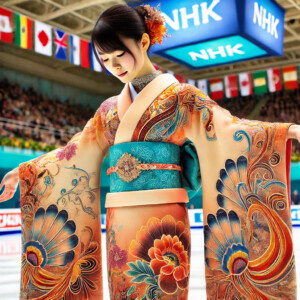
Notable Episode: In 2018, an 18-year-old Japanese figure skater, Rika Kihira, made headlines when she appeared in a stunning furisode during her victory celebration at the NHK Trophy. The sight of a young, modern athlete wearing such a traditional garment beautifully highlighted the fusion of old and new in Japanese culture, garnering international admiration.
2.Tomesode (留袖)
- Kurotomesode (黒留袖):
- Characteristics: Kurotomesode are black kimonos with intricate designs primarily below the waist. These designs often include auspicious motifs such as cranes, pines, or flowers. They are the most formal kimono for married women.
- Occasions: Worn by married women at formal events, especially weddings, where they are typically worn by the mother of the bride or groom.
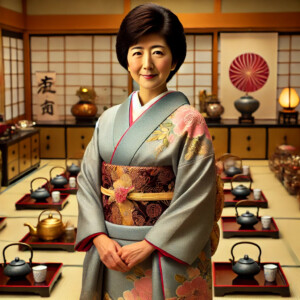
Notable Episode: During the 2019 G20 Summit in Osaka, the wives of world leaders were treated to a cultural tour, including a traditional tea ceremony. Akie Abe, the wife of then-Prime Minister Shinzo Abe, wore a beautiful kurotomesode, which was widely reported and appreciated for showcasing Japan’s rich cultural heritage.
Irotomesode (色留袖):
- Characteristics: Irotomesode are similar to kurotomesode but come in various colors and usually have fewer patterns. They can have one to five family crests (kamon) and are slightly less formal.
- Occasions: Suitable for formal occasions, but less restrictive than kurotomesode, making them appropriate for wedding guests, tea ceremonies, and formal receptions.
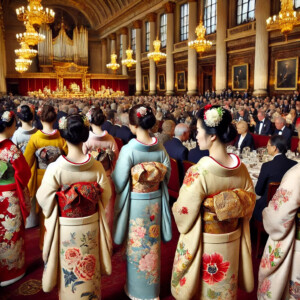
Notable Episode: In 2015, during the state banquet for the Japanese Emperor and Empress in London, many of the Japanese female guests wore irotomesode, which caught the attention of the British press. The vibrant colors and delicate designs of the kimonos were praised for their elegance and beauty.
3.Houmongi (訪問着)
- Characteristics: Houmongi are known for their beautiful and continuous patterns that flow seamlessly across the garment, including the shoulders, sleeves, and hem. They are often dyed and decorated with techniques such as yuzen (a type of resist dyeing) and feature elegant, sophisticated designs.
- Occasions: Houmongi are worn for semi-formal events such as tea ceremonies, weddings, and parties. Their versatility makes them a popular choice for various important gatherings and social functions.
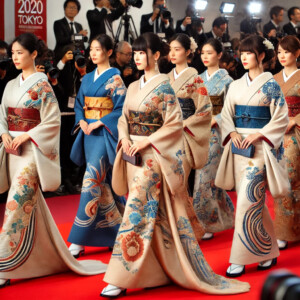
Notable Episode: In 2020, during the Tokyo International Film Festival, several Japanese actresses appeared on the red carpet wearing houmongi. The event received international media coverage, and the actresses were praised for their traditional yet stylish attire, which highlighted Japan’s cultural heritage in a contemporary setting.
4.Tsukesage (付け下げ)
- Characteristics: Tsukesage are similar to houmongi but generally have simpler and more understated patterns that do not flow across the seams. The designs are often positioned on specific areas like the sleeves, hem, and shoulder, creating a balanced yet less elaborate look.
- Occasions: Ideal for semi-formal occasions such as tea ceremonies and parties, tsukesage provide a more subdued elegance compared to houmongi.

Notable Episode: In 2017, during the annual New Year’s reception at the Imperial Palace, Princess Mako wore a beautiful tsukesage. The understated elegance of her kimono was widely covered by international media, highlighting the grace and poise associated with the Japanese royal family.
5.Komon (小紋)
- Characteristics: Komon are casual kimonos characterized by their repeated small patterns, which cover the entire fabric. The designs are subtle and often include motifs like dots, flowers, or geometric shapes.
- Occasions: Komon are perfect for everyday wear or informal outings. They are versatile and can be dressed up or down depending on the accessories and obi used.
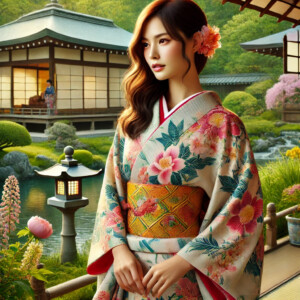
Notable Episode: In 2019, during a visit to Kyoto, Ivanka Trump was seen wearing a komon kimono. The international media praised her for embracing Japanese culture and the casual elegance of the kimono made a significant impression, promoting cultural exchange.
6.Yukata (浴衣)
- Characteristics: Yukata are lightweight, unlined kimonos made from cotton or synthetic fabric, designed to keep the wearer cool during Japan’s hot and humid summers. They are typically brightly colored with bold patterns, and they are easier to wear and care for compared to more formal kimonos.
- Occasions: Yukata are commonly worn during summer festivals (matsuri), fireworks displays (hanabi taikai), and visits to traditional inns (ryokan) or hot springs (onsen). They are also popular as casual loungewear at home.
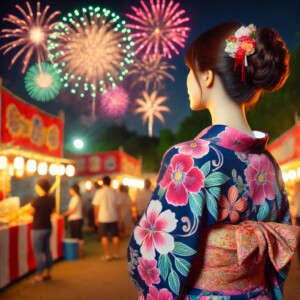
Notable Episode: In 2016, during the Gion Matsuri in Kyoto, several international celebrities, including Tom Cruise, were photographed wearing yukata. The images went viral, bringing global attention to this traditional Japanese summer garment and the festival itself.
7.Shiromuku (白無垢)
- Characteristics: Shiromuku are stunning pure white kimonos worn by brides in traditional Shinto weddings. The all-white ensemble, including the kimono and headpiece, symbolizes the bride’s purity and her willingness to be “dyed” by her husband’s family.
- Occasions: Exclusively worn during traditional Shinto wedding ceremonies, shiromuku highlight the solemnity and sanctity of the wedding ritual.

Notable Episode: In 2013, Princess Noriko of Takamado married Kunimaro Senge in a traditional Shinto ceremony, wearing a beautiful shiromuku. The wedding was widely covered by international media, showcasing the grandeur and tradition of Japanese royal weddings.
The Obi
The obi is a fundamental component of the kimono, adding both aesthetic appeal and structural support. It is a broad sash that wraps around the waist and is tied at the back. The style, material, and tying method of the obi can significantly alter the overall look of the kimono. Here are the main types of obi:
- Maru Obi (丸帯)
- Characteristics: Maru obi are the most formal type of obi, fully patterned on both sides and often featuring intricate designs woven with gold and silver threads. They can be up to 68 cm wide and are quite heavy.
- Occasions: Maru obi are worn with the most formal kimonos, such as furisode and kurotomesode, making them suitable for weddings, formal ceremonies, and significant cultural events.
- Fukuro Obi (袋帯)
- Characteristics: Fukuro obi are slightly less formal than maru obi, with patterns covering about 60% of the fabric. They are narrower and lighter, making them easier to wear.
- Occasions: Fukuro obi are versatile and can be worn with formal to semi-formal kimonos like houmongi and irotomesode. They are appropriate for weddings, tea ceremonies, and other formal gatherings.
- Nagoya Obi (名古屋帯)
- Characteristics: Nagoya obi are designed for convenience and ease of wear. They are pre-sewn into a narrow portion for the waist and a wider portion for the decorative knot. They often feature simpler patterns and are less formal.
- Occasions: Nagoya obi are ideal for casual to semi-formal occasions and are often paired with komon and tsukesage kimonos.
- Hanhaba Obi (半幅帯)
- Characteristics: Hanhaba obi are narrow, typically about half the width of other obi types. They are more casual and come in a variety of colors and designs, often used for simpler, everyday looks.
- Occasions: Perfect for informal settings, hanhaba obi are commonly worn with yukata and casual kimonos for festivals, casual outings, and relaxed social gatherings.
Cultural Significance and Occasions
The kimono is deeply ingrained in Japanese culture, symbolizing elegance, tradition, and a connection to the past. Each type of kimono and obi reflects the occasion’s
Comment